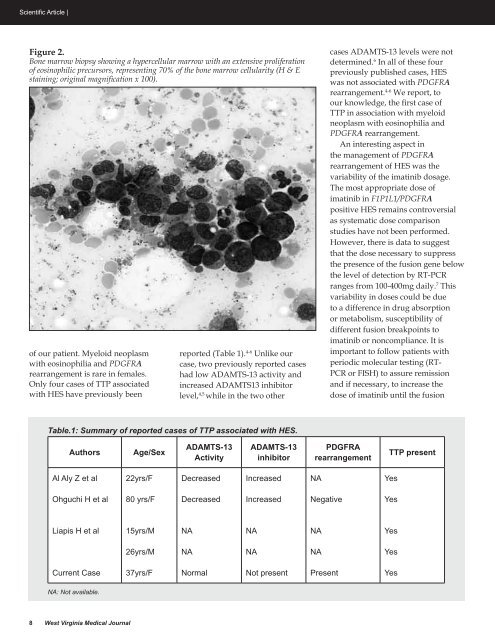March/April - West Virginia State Medical Association
March/April - West Virginia State Medical Association
March/April - West Virginia State Medical Association
Create successful ePaper yourself
Turn your PDF publications into a flip-book with our unique Google optimized e-Paper software.
Scientific Article |<br />
Figure 2.<br />
Bone marrow biopsy showing a hypercellular marrow with an extensive proliferation<br />
of eosinophilic precursors, representing 70% of the bone marrow cellularity (H & E<br />
staining; original magnification x 100).<br />
of our patient. Myeloid neoplasm<br />
with eosinophilia and PDGFRA<br />
rearrangement is rare in females.<br />
Only four cases of TTP associated<br />
with HES have previously been<br />
reported (Table 1). 4-6 Unlike our<br />
case, two previously reported cases<br />
had low ADAMTS-13 activity and<br />
increased ADAMTS13 inhibitor<br />
level, 4,5 while in the two other<br />
cases ADAMTS-13 levels were not<br />
determined. 6 In all of these four<br />
previously published cases, HES<br />
was not associated with PDGFRA<br />
rearrangement. 4-6 We report, to<br />
our knowledge, the first case of<br />
TTP in association with myeloid<br />
neoplasm with eosinophilia and<br />
PDGFRA rearrangement.<br />
An interesting aspect in<br />
the management of PDGFRA<br />
rearrangement of HES was the<br />
variability of the imatinib dosage.<br />
The most appropriate dose of<br />
imatinib in F1P1L1/PDGFRA<br />
positive HES remains controversial<br />
as systematic dose comparison<br />
studies have not been performed.<br />
However, there is data to suggest<br />
that the dose necessary to suppress<br />
the presence of the fusion gene below<br />
the level of detection by RT-PCR<br />
ranges from 100-400mg daily. 7 This<br />
variability in doses could be due<br />
to a difference in drug absorption<br />
or metabolism, susceptibility of<br />
different fusion breakpoints to<br />
imatinib or noncompliance. It is<br />
important to follow patients with<br />
periodic molecular testing (RT-<br />
PCR or FISH) to assure remission<br />
and if necessary, to increase the<br />
dose of imatinib until the fusion<br />
Table.1: Summary of reported cases of TTP associated with HES.<br />
Authors<br />
Age/Sex<br />
ADAMTS-13<br />
Activity<br />
ADAMTS-13<br />
inhibitor<br />
PDGFRA<br />
rearrangement<br />
TTP present<br />
Al Aly Z et al<br />
22yrs/F<br />
Decreased<br />
Increased<br />
NA<br />
Yes<br />
Ohguchi H et al<br />
80 yrs/F<br />
Decreased<br />
Increased<br />
Negative<br />
Yes<br />
Liapis H et al<br />
15yrs/M<br />
NA<br />
NA<br />
NA<br />
Yes<br />
26yrs/M<br />
NA<br />
NA<br />
NA<br />
Yes<br />
Current Case<br />
37yrs/F<br />
Normal<br />
Not present<br />
Present<br />
Yes<br />
NA: Not available.<br />
8 <strong>West</strong> <strong>Virginia</strong> <strong>Medical</strong> Journal















